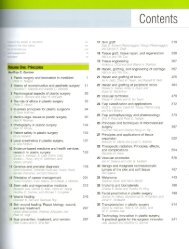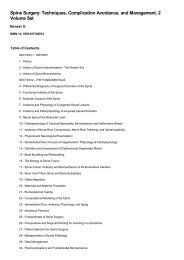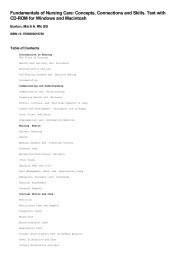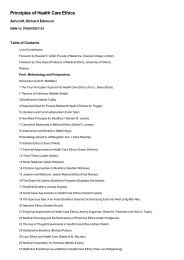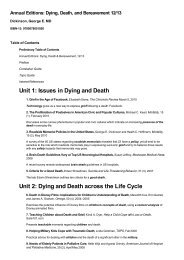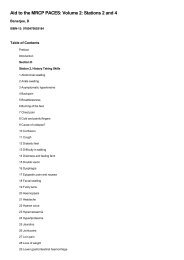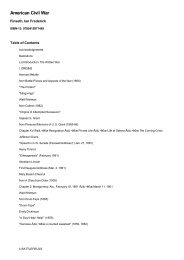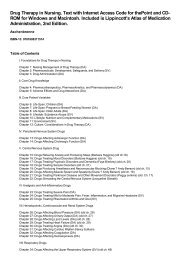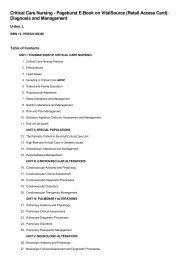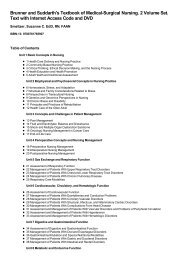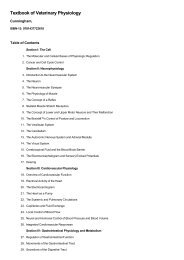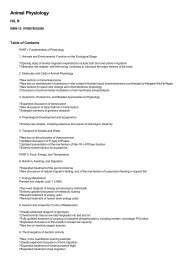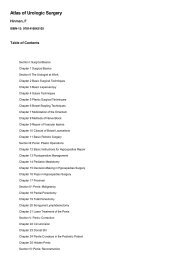Procedures Manual to Accompany Dental Hygiene: Theory and
Procedures Manual to Accompany Dental Hygiene: Theory and
Procedures Manual to Accompany Dental Hygiene: Theory and
Create successful ePaper yourself
Turn your PDF publications into a flip-book with our unique Google optimized e-Paper software.
<strong>Procedures</strong> <strong>Manual</strong> <strong>to</strong> <strong>Accompany</strong> <strong>Dental</strong> <strong>Hygiene</strong>: <strong>Theory</strong> <strong>and</strong> Practice<br />
Darby, Michele Leonardi MS<br />
ISBN-13: 9781416061007<br />
Table of Contents<br />
PART 1: DENTAL HYGIENE PROCEDURES<br />
Section 2: Preparation for the Appointment<br />
Chapter 8: Medical Emergencies<br />
Procedure 8-1: Initial Assessment<br />
Procedure 8-2: Rescue Breathing–Adult, Child, Infant<br />
Procedure 8-3: Single-Rescuer CPR–Adult, Child, Infant<br />
Procedure 8-4: Two-Rescuer CPR–Adult <strong>and</strong> Child<br />
Procedure 8-5: Single-Rescuer CPR Using an AED–Adult <strong>and</strong> Child<br />
Procedure 8-6: Conscious Choking–Adult <strong>and</strong> Child<br />
Procedure 8-7: Unconscious Choking–Adult <strong>and</strong> Child<br />
Procedure 8-8: Conscious Choking–Infant<br />
Procedure 8-9: Unconscious Choking–Infant<br />
Section 3: Assessments<br />
Chapter 11: Vital Signs<br />
Procedure 11-1: Taking an Oral Temperature Measurement with a Mercury-in-Glass Thermometer<br />
Procedure 11-2: Taking an Oral Temperature Measurement with an Electric Thermometer<br />
Procedure 11-3: Measuring the Radial Pulse<br />
Procedure 11-4: Measuring Respirations<br />
Procedure 11-5: Assessing Blood Pressure by Auscultation<br />
Chapter 13: Extraoral <strong>and</strong> Intraoral Clinical Assessment<br />
Procedure 13-1: Conducting Extraoral Assessments<br />
Procedure 13-2: Conducting Intraoral Assessments<br />
Chapter 14: Assessment of the Dentition<br />
Procedure 14-1: Use of an Electric Pulp Tester <strong>to</strong> Determine Pulp Vitality<br />
Chapter 15: Oral <strong>Hygiene</strong> Assessment: Soft Deposits <strong>and</strong> Hard Deposits<br />
Procedure 15-1: Oral Deposit Assessment<br />
Section 5: Implementation<br />
Chapter 22: Mechanical Plaque Biofilm Control: Interdental & Supplemental Self-Care Devices<br />
Procedure 22-1: Spool Flossing Method–Adults<br />
Procedure 22-2: Loop Flossing Method–Children <strong>and</strong> Clients with Limited <strong>Manual</strong> Dexterity<br />
Procedure 22-3: Use of a Floss Holder<br />
Procedure 22-4: Use of a Floss Threader<br />
Procedure 22-5: Use of a Toothpick in a Toothpick Holder<br />
Procedure 22-6: Use of a Wedge Stimula<strong>to</strong>r<br />
Procedure 22-7: Use of a Rubber Tip Stimula<strong>to</strong>r<br />
Procedure 22-8: Use of an Interdental Brush<br />
Procedure 22-9: Use of a Tongue Cleaner<br />
Procedure 22-10: Use of a <strong>Dental</strong> Water Jet–Jet Tip<br />
Chapter 24: H<strong>and</strong>-Activated Instruments<br />
Procedure 24-1: Basic Positioning for Assessment <strong>and</strong> Treatment<br />
Procedure 24-2: Use of the Periodontal Probe<br />
Procedure 24-3: Use of the Periodontal Explorer
Procedure 24-4: Use of the Anterior Sickle Scaler<br />
Procedure 24-5: Use of the Posterior Sickle Scaler<br />
Procedure 24-6: Use of the Universal Curet<br />
Procedure 24-7: Use of Area-Specific Curets<br />
Procedure 24-8: Opera<strong>to</strong>r Positioning Strategies of Protective Scaling<br />
Chapter 25: Ultrasonic Instrumentation<br />
Procedure 25-1: Instrumentation with the Magne<strong>to</strong>strictive Ultrasonic Unit<br />
Chapter 26: Root Morphology <strong>and</strong> Instrumentation Applications<br />
Procedure 26-1: Root Morphology <strong>and</strong> Implications for Root Instrumentation<br />
Chapter 27: Management of Extrinsic <strong>and</strong> Intrinsic Stains<br />
Procedure 27-1: Rubber-Cup Polishing<br />
Procedure 27-2: Air Polishing<br />
Chapter 28: Decision Making Related <strong>to</strong> Nonsurgical Periodontal Therapy<br />
Procedure 28-1: Use of Extended-Shank <strong>and</strong> Mini-Blade Curets<br />
Chapter 29: Chemotherapy for the Control of Periodontal Diseases<br />
Procedure 29-1: Placement of Controlled-Release Drug: Tetracycline Fiber<br />
Procedure 29-2: Placement of Controlled-Release Drug: Chlorhexidine Chip<br />
Procedure 29-3: Placement of Controlled-Release Drug: Doxycycline Gel<br />
Procedure 29-4: Placement of Controlled-Release Drug: Minocycline Hydrochloride Microspheres<br />
Chapter 30: Acute Gingival <strong>and</strong> Periodontal Conditions, Lesions of Endodontic Origin, <strong>and</strong> Avulsed Teeth<br />
Procedure 30-1: Emergency Management of the Avulsed Tooth<br />
Chapter 31: Caries Management: Fluorides, Chlorhexidine, Xyli<strong>to</strong>l, <strong>and</strong> Amorphous Calcium Phosphates<br />
Procedure 31-1: Professionally Applied Topical Fluoride Using the Tray Technique<br />
Procedure 31-2: Professionally Applied Sodium Fluoride Varnish Using the Paint-On Technique<br />
Chapter 32: Pit <strong>and</strong> Fissure Sealants<br />
Procedure 32-1: Applying Light-Cured (Pho<strong>to</strong>polymerized) Sealants<br />
Procedure 32-2: Applying Self-Cured (Au<strong>to</strong>polymerizing) Sealants<br />
Chapter 35: Impressions, Study Casts, <strong>and</strong> Oral Stents<br />
Procedure 35-1: Selecting the Correct Tray Size <strong>and</strong> Preparing It for Use<br />
Procedure 35-2: Mixing Alginate<br />
Procedure 35-3: Making a M<strong>and</strong>ibular Preliminary Impression<br />
Procedure 35-4: Making a Maxillary Preliminary Impression<br />
Procedure 35-6: Making a Wax-Bite Registration<br />
Procedure 35-6: Pouring the Cast <strong>and</strong> the Base<br />
Procedure 35-7: Constructing <strong>and</strong> Cus<strong>to</strong>m-Made Stent<br />
Chapter 36: Res<strong>to</strong>rative Therapy<br />
Procedure 36-1: Applying a Rubber Dam<br />
Procedure 36-2: Removing a Rubber Dam<br />
Procedure 36-3: Placing a Tofflemire Matrix System<br />
Procedure 36-4: Placing an Amalgam Res<strong>to</strong>ration<br />
Procedure 36-5: Finishing <strong>and</strong> Polishing Amalgam Res<strong>to</strong>rations<br />
Procedure 36-6: Placing <strong>and</strong> Finishing a Resin Composite Res<strong>to</strong>ration<br />
Procedure 36-7: Placing a Glass Ionomer Cement Res<strong>to</strong>ration of Class V Abrasion Lesions<br />
Procedure 36-8: Res<strong>to</strong>ring a Carious Lesion Using Alternative Res<strong>to</strong>rative Therapy<br />
Procedure 36-9: Placing a Stainless Steel Crown<br />
Procedure 36-10: Placing a Retraction Cord<br />
Procedure 36-11: Preparing Reinforced Zinc Oxide <strong>and</strong> Eugenol Temporary Res<strong>to</strong>rations (Class II Cavity Preparation)<br />
Section 6: Pain <strong>and</strong> Anxiety Control<br />
Chapter 37: Behavior Management of <strong>Dental</strong> Fear <strong>and</strong> Anxiety
Procedure 37-1: Preparing the Client for Relaxation Therapy<br />
Procedure 37-2: Teaching Deep Breathing <strong>to</strong> a Fearful Client<br />
Procedure 37-3: Guided Imagery<br />
Procedure 37-4: Guiding the Client in<strong>to</strong> Progressive Muscle Relaxation<br />
Procedure 37-5: Guiding the Client in<strong>to</strong> Progressive Relaxation<br />
Procedure 37-6: Awakening the Client after Relaxation Therapy<br />
Chapter 38: <strong>Dental</strong> Hypersensitivity Management<br />
Procedure 38-1: Administration of Desensitizing Agents<br />
Chapter 39: Local Anesthesia<br />
Procedure 39-1: Loading the Metallic or Plastic Cartridge-Type Syringe<br />
Procedure 39-2: Unloading the Breech-Loading Metallic or Plastic Cartridge-Type Syringe<br />
Chapter 40: Nitrous Oxide–Oxygen Analgesia<br />
Procedure 40-1: Administration of Nitrous Oxide–Oxygen Analgesic Using the Constant Liter Flow Technique<br />
Section 7: Individuals with Special Needs<br />
Chapter 41: Persons with Disabilities<br />
Procedure 41-1: Transferring a Client from a Wheelchair <strong>to</strong> a <strong>Dental</strong> Chair Using a One-Person Lift<br />
Procedure 41-2: Transferring a Client from a Wheelchair <strong>to</strong> a <strong>Dental</strong> Chair Using a Two-Person Lift<br />
Chapter 45: Persons with HIV Infection<br />
Procedure 45-1: <strong>Dental</strong> <strong>Hygiene</strong> Care for the HIV-Infected Client<br />
Chapter 49: Persons with Respira<strong>to</strong>ry Diseases<br />
Procedure 49-1: Management of an Acute Asthmatic Episode<br />
Chapter 55: Persons with Fixed <strong>and</strong> Removable Dentures<br />
Procedure 55-1: <strong>Dental</strong> <strong>Hygiene</strong> Care for Clients with Fixed <strong>and</strong> Removable Dentures<br />
Procedure 55-2: Daily Oral <strong>and</strong> Denture <strong>Hygiene</strong> Care for Individuals with Removable Prostheses<br />
Procedure 55-3: Daily Oral Care for Individuals with Fixed Prostheses<br />
PART 2: CLIENT EDUCATION HANDOUTS<br />
Section 1: General Dentistry<br />
Congenitally Missing Teeth* Fluorosis, Mottled Enamel, <strong>and</strong> White Spots * You Can Have Whiter Teeth! * At-Home Tray<br />
System: Tooth Whitening Instructions * Prophylactic Antiobiotics for Premedication * Staying Well: How <strong>to</strong> Keep Your Mouth<br />
Healthy * How <strong>to</strong> Brush! How <strong>to</strong> Floss! * Juice Drink Alert * Prevention of Decay * When Radiographs Are Necessary *<br />
Reversing Decay * Topical Fluoride: At Home <strong>and</strong> in the <strong>Dental</strong> Office * Attrition <strong>and</strong> Abrasion * Bad Breath * Sensitive Teeth *<br />
Xeros<strong>to</strong>mia: Dry Mouth Syndrome<br />
Section 2: Pediatric Dentistry<br />
A Childâ€s First Visit <strong>to</strong> the Dentist * Early Childhood Caries * Eruption Patterns of Teeth * Prevention of <strong>Dental</strong> Disease in<br />
Infants <strong>and</strong> Children * Sealants * Supplemental Fluoride<br />
Section 3: Periodontics<br />
Furcation Involvement * Gingival Hyperplasia * Gingivitis * Insufficient Attached Gingiva * Necrotizing Periodontal Disease *<br />
Periodontal Disease * Periodontal Disease <strong>and</strong> Systemic Health * Pocket Depth Measurement * Smoking <strong>and</strong> Adult<br />
Periodontitis * Prophylaxis * Scaling <strong>and</strong> Root Planing * Scaling <strong>and</strong> Root Planing: Posprocedure Instructions * Scaling <strong>and</strong><br />
Root Planing: Reevaluation * Soft Tissue Management * Chlorhexidine Gluconate Oral Rinse 0.12% * Periostat: Systemic<br />
Submicrobial Dose of Doxycycline * Site-Specific Antibiotic Therapy * Subgingival Irrigation<br />
PART 3: ASSESSMENT, EVALUATION, AND CLIENT CARE RESOURCES



